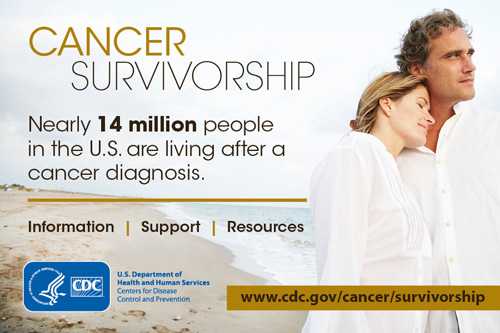CDC responds to broad challenges facing US cancer survivors
Physical, financial, psychological needs reported
This website is archived for historical purposes and is no longer being maintained or updated.
Press Release
For immediate Release: Wednesday, November 18, 2015
Contact: Media Relations
(404) 639-3286
The number of cancer survivors — people who live after a cancer diagnosis — is expected to grow substantially over the next few decades as the U.S. population ages and as early detection methods and treatments continue to improve. Updates on how the Centers for Disease Control and Prevention is helping Americans meet the challenges of cancer survivorship were published online today at www.ajpmonline.org and appear in the December issue of the American Journal of Preventive Medicine.
The supplement, “Addressing Cancer Survivorship through Public Health Research, Surveillance, and Programs,” concludes that concrete plans are needed to ensure that the U.S. health care system can meet survivors’ future needs.
“By 2025, there will be more than 24 million people living after a cancer diagnosis,” said CDC Principal Deputy Director Anne Schuchat, M.D. “In addition to better prevention and treatment of cancer, we must plan for the wide variety of issues that people may face after cancer, including physical, financial, and psychological hardships.”
Selected findings from CDC-authored articles in the supplement:
- Sixty percent of breast cancer survivors surveyed reported having problems with thinking, memory, and concentration after receiving chemotherapy and/or hormone treatment for breast cancer. Of those women, 37 percent said they discussed the problems with their health care provider and 15 percent reported receiving medication, psychotherapy, or other interventions to treat their symptoms.
- Some people treated for colorectal (colon) cancer face barriers to eating healthy and getting enough physical activity to reduce their risk of having the cancer recur. These barriers include a lack of knowledge about how to maintain a healthy diet and limit alcohol use.
- Higher out-of-pocket medical costs can keep survivors from getting access to the follow-up care they need.
“When we think about cancer treatments, we tend to think of the physical toll they take on patients who are in active treatment. But these articles highlight challenges that can affect survivors for the rest of their lives,” said Lisa Richardson M.D., M.P.H., director, CDC’s Division of Cancer Prevention and Control.
The journal supplement includes 12 articles on research, surveillance, education campaigns, and partnerships that improve the experiences of survivors, their families, friends, and caregivers.
An introduction to the supplement’s opening article reviews CDC’s ongoing work in cancer survivorship, which includes surveillance to determine burden, research to determine the health and economic impact of cancer on survivors, and working with state and territorial partners to support incorporating survivorship activities into their comprehensive cancer control efforts.
For more information about this supplement and CDC’s cancer-related work, visit www.cdc.gov/cancer, www.cdc.gov/cancer/survivorship and www.cdc.gov/cancer/dcpc/research/articles/survivorship-supplement.htm.
- Page last reviewed: November 18, 2015 (archived document)
- Content source:
Error processing SSI file


 ShareCompartir
ShareCompartir
